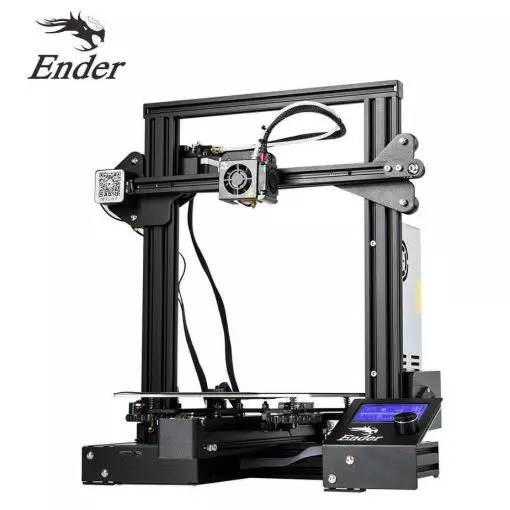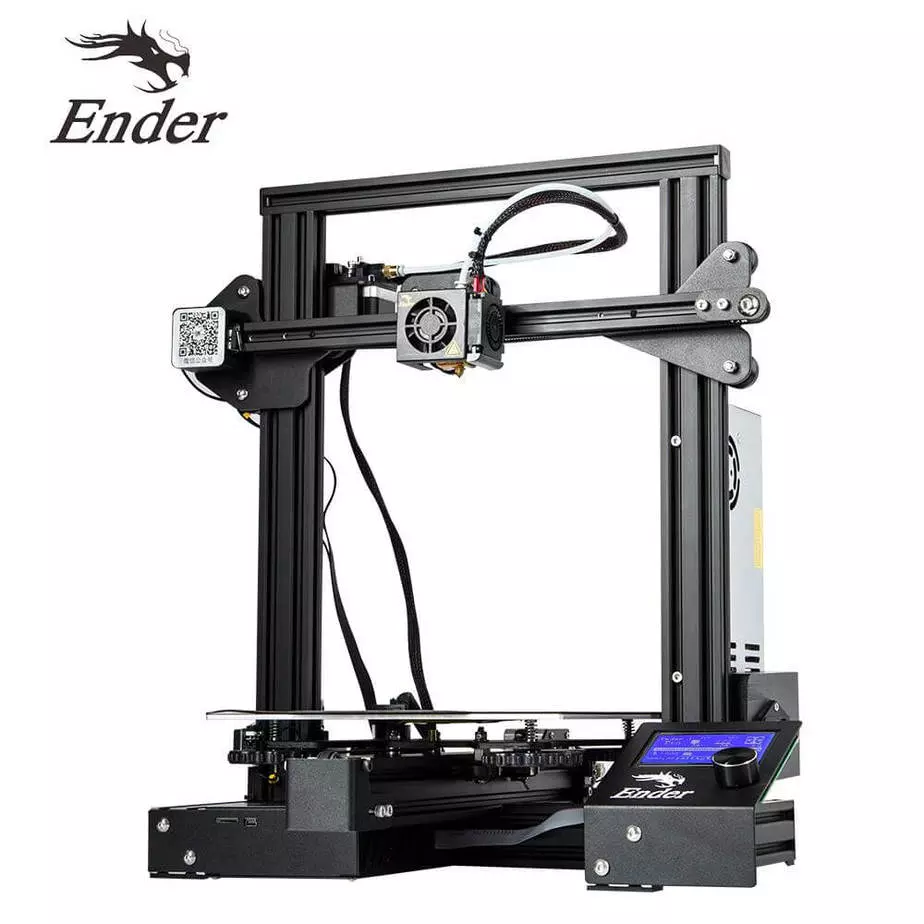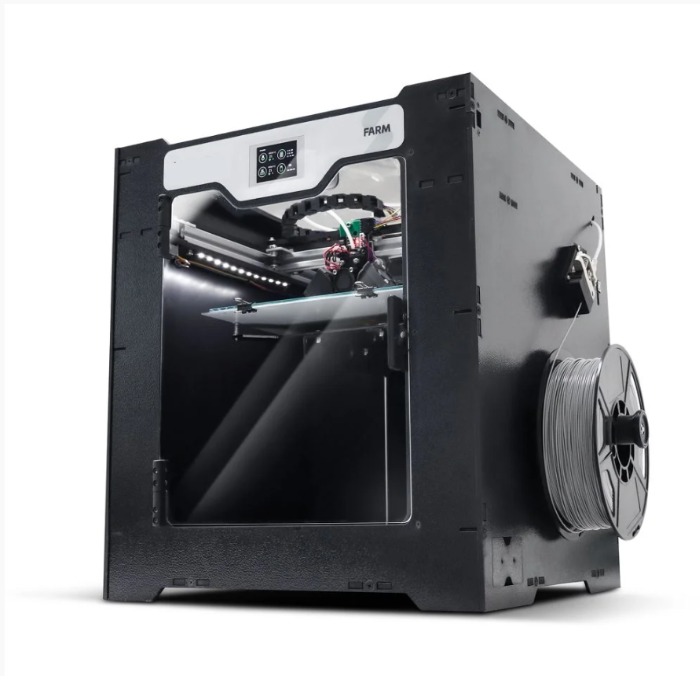Compare Ender 3 vs Ender 3 PRO vs FARM
Comparison between the best 3D printers
Choose the best 3D printer at the best price. The cheapest 3D printers are here.
Buy a 3D printer here with 3D Fila.
 |
 |
 |
|
| Model | Ender 3[BUY Ender 3] |
Ender 3 PRO[BUY Ender 3 PRO] |
FARM |
| Printing Material | Filament | Filament | Filament |
| Estimated price | $210,00 | $258,00 | $1127,00 |
| Fabricante | Creality 3D | Creality 3D | Sethi 3D |
| Release Year | 2018 | 2019 | 2021 |
| Print Volume [mm] | 220x220x250 | 220x220x250 | 240x240x240 |
| Printer Size [mm] | 440x440x465 | 440x440x465 | 550x42x500 |
| Weight [kg] | 6,62 | 6,62 | 15,7 |
| Power Loss Recovery | NO | NO | YES |
| Enclosed printer | NO | NO | NO |
| Bed Leveling | Manual | Manual | Automatic |
| Filament End Sensor | NO | NO | YES |
| Bed type | Heated | Heated | Heated |
| Power supply system | Bowden | Bowden | Bowden |
| Standard nozzle | 0,4 | 0,4 | 0,4 |
| Maximum Nozzle Temperature [°C] | 255 | 255 | 270 |
| Maximum Bed Temperature [°C] | 110 | 110 | 120 |
| Maximum printing speed [mm/s] | 180 | 180 | 80 |
| Filament holder | YES | YES | YES |
| Camera for supervision | NO | NO | NO |
| Recommended filaments | PLA, TPU, ABS, PETG | PLA, TPU, ABS, PETG | PLA, PETG, Tritan, Flex, ABS |
| Recommended slicers | Cura, Simplify, Slic3r | Cura, Simplify, Slic3r | Cura, Simplify, Slic3r |
| Maximum Resolution [mm] | 0,1 | 0,1 | |
| Processor | 8 bits | 32 bits | |
| Display | Mono | Mono | Touchscreen TFT |
| Power Supply | 24V / 270W | 24V / 360W Meanwell | 450 W |
| Connectivity | SD / USB | SD / USB | USB |
| Operating systems | Windows, Mac, Linux | Windows, Mac, Linux | Windows, Mac, Linux |
| Date of registration in the system | 2021-04-13 | 2021-04-14 | 2022-10-11 |
| Release date | 2018 | 2019 | 2021 |
| Extra features | The Ender 3 V1 is a DIY assembly 3D printer, a sales leader since 2017, standing out for its cost-benefit. With a wide printing capacity, it has a CNC machined structure for precision and stability. It offers high-precision prints with low noise, thanks to its innovative V-profile and pulleys. It has a self-adhesive magnetic platform for easy removal of models and excellent adhesion. The Ender 3 heats up quickly, reaching 100°C in 5 minutes, ideal for agile prints. It includes protection against power failures, allowing you to resume printing after interruptions, saving time and material. | The Ender 3 Pro stands out for its beginner-friendly assembly and easily modifiable structure. With a 350W power supply, it heats up quickly and has a simple application that offers good print quality. However, its motors and fans are noisy, and the interface seems outdated. Assembly is accessible, without the need for advanced techniques, and it has integrated belt tensioners. It includes a detailed guide and supports microSD card and USB. | Sethis Farm printer offers a generous 240 x 240 x 240 mm print area, ideal for large projects. Its intuitive touchscreen display makes it easy to operate, while the intelligent sensor prevents problems by detecting filament shortages or jams. Its power recovery feature allows you to resume printing after interruptions. It stands out for its 9-point optical auto-leveling and high-performance heated bed, ensuring accuracy and versatility on different materials. Its 32-bit electronics and silent drivers promote a smooth and efficient experience. In addition, the Farm has a closed cabinet, expanding the range of usable polymers, and a turbo cooling system to speed up the process between prints. The machine also offers practicality with a storage drawer and simplified software updates. |
| Support for multiple colors and materials (AMS and CFS) | NO | NO | NO |
Notes * |
|||
| Cost-benefit | 6 / 10 | 6 / 10 | 6 / 10 |
| Hardware | 0.5 / 10 | 0.5 / 10 | 3 / 10 |
| Screen | . | . | . |
| Print volume | 3 / 10 | 3 / 10 | 3 / 10 |
| Performance | 1 / 10 | 1 / 10 | 0 / 10 |
| [BUY Ender 3] | [BUY Ender 3 PRO] |
Conclusion |
| In comparing the three 3D printers, the Ender 3, Ender 3 Pro, and Sethi Farm, several key differences emerge that can guide your purchasing decision. Starting with the Ender 3 and Ender 3 Pro, both models are offered at a more affordable price point and share similar specifications, including print volume and the type of bed used. Their DIY assembly approach and the simplicity of operation make them particularly appealing for beginners. However, users will have to deal with manual bed leveling and lack of advanced features like filament sensors. The performance and quality may be adequate for hobbyists or those looking to experiment without a considerable investment. In contrast, the Sethi Farm, while significantly more expensive, offers a richer array of features that cater to users with more ambitious printing needs. Its larger print volume, automatic bed leveling, and recovery features add convenience and reliability for serious users or small businesses. It supports a variety of materials and comes with a user-friendly touchscreen interface, further enhancing its usability. Ultimately, if your priority is affordability and you're comfortable with a hands-on approach, the Ender 3 or Ender 3 Pro are excellent choices. However, if you're looking for enhanced performance, larger capacity, and cutting-edge features, the Sethi Farm justifies its higher price. In conclusion, the decision rests on balancing features versus cost; if you're willing to invest more for additional capabilities, the Sethi Farm could prove to be the better long-term investment. |

